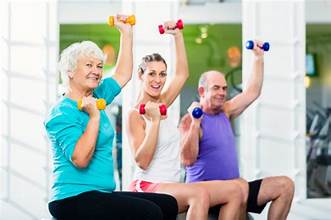As we become older, it’s more crucial than ever to put our health and fitness first. Regular exercise plays a crucial role in promoting a healthy lifestyle, especially for senior citizens. Beyond physical fitness, exercise offers a myriad of benefits for the mind, body, and overall well-being in the golden years.
In this article, we will explore the importance of regular exercise for senior citizens and provide practical health and fitness tips to help them stay healthy and active.
-
Physical Benefits:
The first health and fitness tips is doing regular exercise. Regular exercise has numerous physical benefits for older adults. It helps maintain and improve cardiovascular health, reducing the risk of heart disease and stroke. Exercise also strengthens muscles and bones, preventing age-related muscle loss and osteoporosis.
Moreover, it improves flexibility and mobility, making daily activities easier and reducing the risk of falls and injuries.
-
Cognitive Benefits:
Exercise is not just beneficial for physical health, but also cognitive function in older adults. Studies have shown that regular physical activity can improve memory and concentration, reduce the risk of cognitive decline, and lower the chances of developing dementia and Alzheimer’s disease.
-
Emotional Well-being:
The effects of exercise on mental and emotional health are significant. It helps reduce symptoms of anxiety and depression, boosts mood, and enhances overall psychological well-being. Regular physical activity releases endorphins, the body’s natural feel-good hormones, which can significantly improve one’s mood and outlook on life.
-
Social Engagement:
Regular exercise provides an opportunity for senior citizens to socialize and connect with others. Joining group fitness classes or participating in community actuuivities can help older adults foster new friendships, combat loneliness, and improve their overall social and emotional well-being.
-
Tips for Starting an Exercise Routine:
For seniors who have never exercised regularly or are unsure where to start, it’s important to ease into a new routine gradually.
1. Consult a healthcare professional:
Before starting any exercise program, it’s important to consult a healthcare professional to ensure that you are physically fit for exercise and to address any specific concerns or limitations.
2. Choose activities you enjoy:
Engaging in activities that are enjoyable increases the likelihood of adhering to an exercise routine. Whether it’s walking, swimming, dancing, or tai chi, finding enjoyable activities will make exercise a more pleasant experience.
3. Start slow and listen to your body:
Begin with low-impact exercises and gradually increase the intensity and duration over time. Pay attention to your body’s signals and adjust your routine accordingly to prevent overexertion or injury.
4. Incorporate strength training:
Strength training exercises, such as lifting weights or using resistance bands, are essential for maintaining muscle mass and bone density in older adults. Include strength training exercises at least twice a week, focusing on all major muscle groups.
5. Stay hydrated:
Drink plenty of water before, during, and after exercise to stay well-hydrated, especially during hot weather or intense workouts.
6. Warm-up and cool-down:
Before starting your exercise session, take a few minutes to warm up your muscles with gentle stretches or a short walk. Afterward, end your exercise routine with a cool-down period to gradually lower your heart rate and stretch your muscles.
7. Find a workout buddy:
Exercising with a friend or family member can provide added motivation and support. Having a workout buddy can make exercise more enjoyable and help you stay accountable.
-
Overcoming Common Barriers:
Several barriers might hinder older adults from engaging in regular exercise.
1. Lack of time:
Break exercise into smaller sessions throughout the day, such as three 10-minute walks instead of one 30-minute session.
2. Lack of motivation:
Set realistic goals, track progress, and reward yourself for meeting milestones. Additionally, find a workout routine or activity that aligns with your interests and preferences.
3. Physical limitations:
Modify exercises to accommodate any physical limitations or chronic conditions. Consult a certified fitness professional who specializes in working with older adults or seek out specific exercise programs designed for seniors.
4. Fear of injury:
Start with low-impact exercises, focus on proper form and technique, and begin under the guidance of a trained professional.
-
Safety Considerations:
While exercise is generally safe for most older adults, it’s essential to prioritize safety. Some key precautions include:
- Always warm up and cool down properly.
- Wear appropriate footwear and comfortable clothing.
- Exercise in well-lit areas and be mindful of tripping hazards.
- Use assistive devices, if necessary, to ensure stability and balance.
- Listen to your body and stop exercising if you feel pain, dizziness, or shortness of breath.
Conclusion:
Regular exercise is paramount for senior citizens to maintain good health, independence, and a high quality of life. By incorporating physical activity into their daily routine, older adults can experience numerous physical, cognitive, and emotional benefits. Remember to start slowly, choose activities that you enjoy, and listen to your body. With a well-designed exercise program tailored to their needs, older adults can enjoy the many benefits that come with an active and healthy lifestyle.











